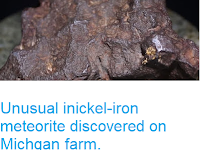Magnetic fields are believed to have played an important role in the accretion of material within the protoplanetary disk from which our Solar System formed, but finding evidence of such ancient fields has proved difficult. In theory, traces of ancient magnetic fields could be preserved in certain minerals within unequilibrated chondrites (asteroids that formed within the protoplanetary disk, and which have not undergone any significant subsequent alteration. The best candidates for this are low-nickel (i.e. high iron) kamacite grains with uniform magnetic fields, preserved within dusty olivine crystals from unequilibrated chondrites, though finding such mineral grains requires some dedication, so that ancient uniform magnetic fields have been found to date in mineral grains from only a single source, the Semarkona Meteorite, a chondritic meteorite that fell to Earth in Madhya Pradesh, India, in October 1940. All other such grains examined to date have possessed non-uniform magnetic fields, the long-term stability of which is uncertain.
In a paper published in the journal Nature Communications on 21 March 2018, a team of scientists led by Jay Shah of the Department of Earth Science and Engineering at Imperial College London, the Department of Earth Sciences at the Natural History Museum, and the Department of Earth, Atmospheric and Planetary Sciences at the Massachusetts Institute of Technology, describe a magnetized kamacite grain from the Bishunpur Meteorite, an unequilibrated ordinary chondrite that is thought to have formed early in the history of the Solar System (about 4.6 billion years ago) and not undergone significant subsequent alteration before landing in Uttar Pradesh, India, in April 1895.
Like all other previously examined low-nickel kamacite grains, except those from the Semarkona Meteorite, the Bashipur Meteorite grains appear to have a non-uniform magnetic field. Shah et al took nineteen such grains, 150–600 nm in size, and examined them using a scanning tunnelling electron microscope to perform off-axis electron holography scans, first at room temperature and then at 100°C intervals until 800°C was reached, with the samples being held at each temperature step for ten minutes before being scanned.
Using this method, Shah et al. were able to establish that the non-uniform magnetic fields were in fact vortexes, and that they remained stable when heated to 600°C, twice as much heating than they are likely to have encountered due within an asteroid over the course of the history of the Solar System (after this the grain began to react chemically with the surrounding olivine).
Like all other previously examined low-nickel kamacite grains, except those from the Semarkona Meteorite, the Bashipur Meteorite grains appear to have a non-uniform magnetic field. Shah et al took nineteen such grains, 150–600 nm in size, and examined them using a scanning tunnelling electron microscope to perform off-axis electron holography scans, first at room temperature and then at 100°C intervals until 800°C was reached, with the samples being held at each temperature step for ten minutes before being scanned.
Using this method, Shah et al. were able to establish that the non-uniform magnetic fields were in fact vortexes, and that they remained stable when heated to 600°C, twice as much heating than they are likely to have encountered due within an asteroid over the course of the history of the Solar System (after this the grain began to react chemically with the surrounding olivine).
Magnetic induction map of a Bishunpur kamacite grain. Magnetic induction map of a kamacite grain in dusty olivine reconstructed from electron holograms acquired at room temperature. The contour spacing is π radians. The direction of the projected in-plane magnetic induction is indicated by the arrows and the colour wheel. Scale bar is 200 nm. Shah et al. (2018).
See also...
Follow Sciency Thoughts on Facebook.







